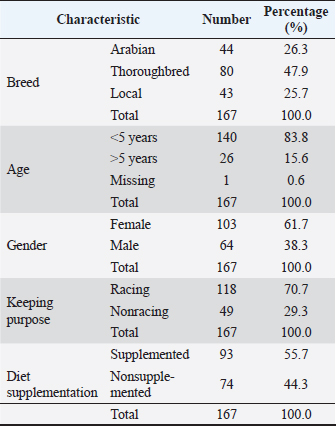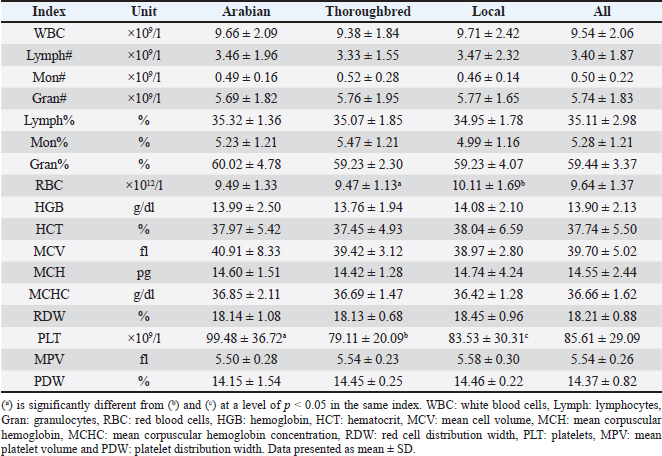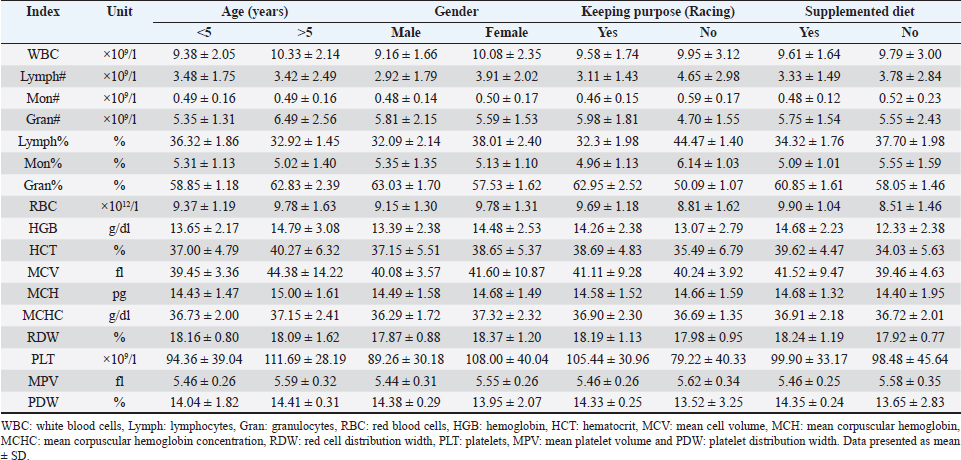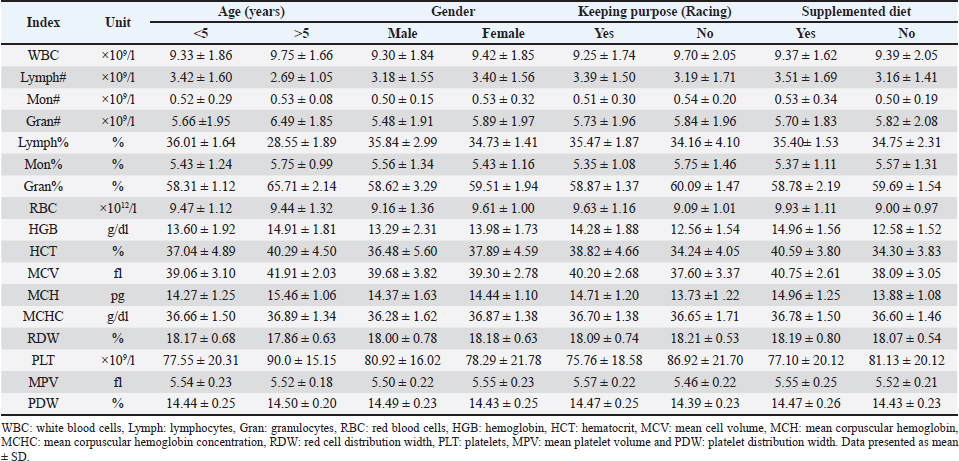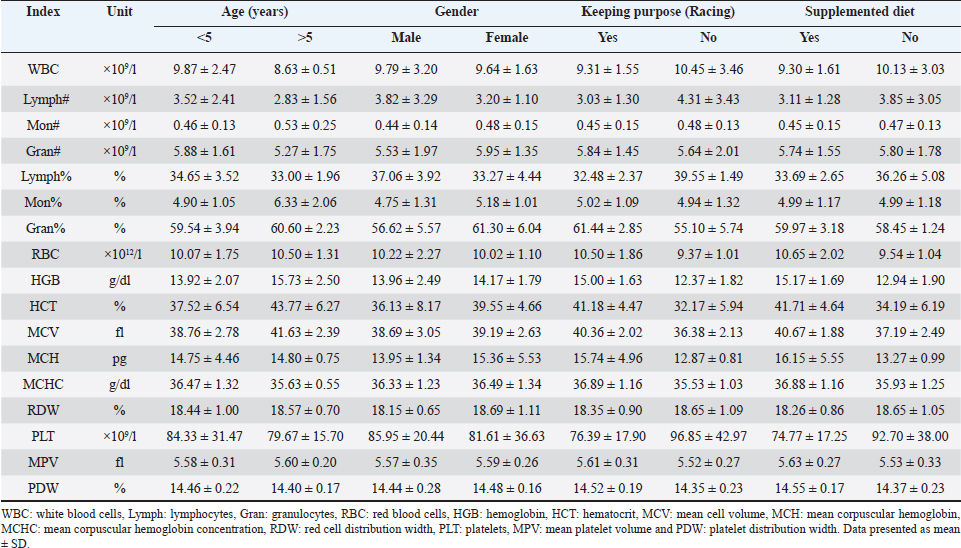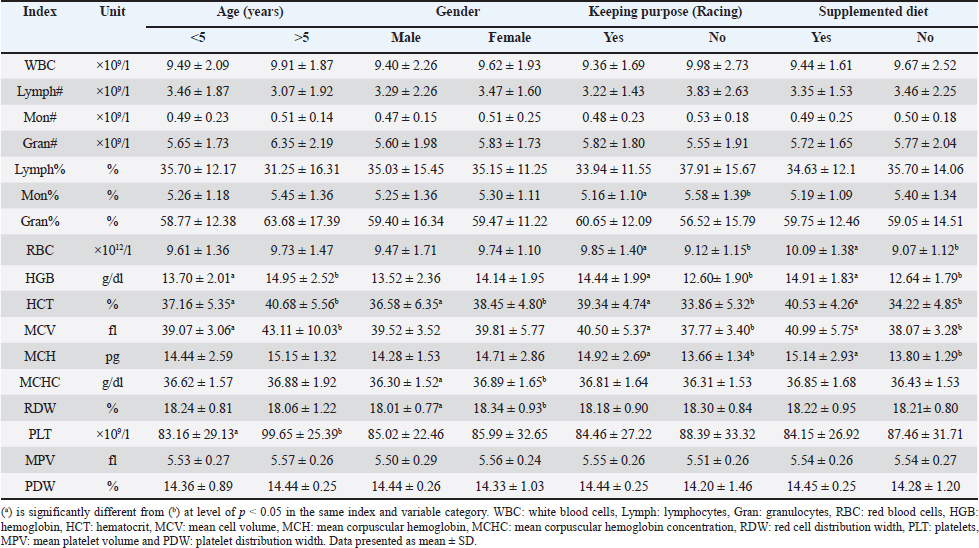
| Research Article | ||
Open Vet J. 2023; 13(12): 1696-1707 Open Veterinary Journal, (2023), Vol. 13(12): 1696–1707 Original Research Hematological reference values of horses in Western Libya and their relationship to breed, age, and managementOsama K. Sawesi1, Abdulkareem K. Elbaz2†, Abdusalam S. Mahmoud3†, Enass M. Duro4, Abdulnassar A. Alteab1, Khaled K. Milad1,5 and Emad M. Bennuor1*1Department of Internal Medicine, Faculty of Veterinary Medicine, University of Tripoli, Tripoli, Libya 2Department of Microbiology and Parasitology, Faculty of Veterinary Medicine, University of Tripoli, Tripoli, Libya 3Department of Preventive Medicine, Faculty of Veterinary Medicine, University of Tripoli, Tripoli, Libya 4Sheffield Centre for Health and Related Research, University of Sheffield, Sheffield, UK 5Sebaq Veterinary Clinic, Tripoli, Libya *Corresponding Author: Emad M. Bennuor. Department of Internal Medicine, Faculty of Veterinary Medicine, University of Tripoli, Tripoli, Libya. Email: e.bennour [at] uot.edu.ly †Authors contributed equally to this work Submitted: 31/10/2023 Accepted: 04/12/2023 Published: 31/12/2023 © 2023 Open Veterinary Journal
AbstractBackground: Hematological evaluation is an important step for health assessment in equine medicine. Besides biochemical tests, that evaluation could be pivotal for diagnosis, prognosis, and treatment monitoring. In Libya, the horse population has drastically increased in the last years, and hitherto, no report addressed the reference hematological values for the existing equine breeds. Aim: This study aimed to establish the reference for hematological indices of traditional equestrian and stud-farm equine breeds in Western Libya in regard to some variables such as individual characteristics, management system, and rearing purpose. Methods: Blood samples of 167 horses of Arabian, Thoroughbred, and local breeds were collected from an area covering a large part of Western Libya and complete blood counts of the samples were performed using a hematological auto-analyzer. The collected data were statistically analyzed using the Statistical Package for Social Science software. Results: Hematological reference indices were generated for the aforementioned equine breeds in Western Libya. The equine hematological profile was variable according to some individual and management factors. In addition, the significant effects of those factors were usually restricted to erythrocyte- and platelets (PLTs)-related indices. In terms of breed influence, Thoroughbreds had significantly lower erythrocyte counts of red blood cells (RBCs) compared to local horses (p=0.04), and Arabian horses showed significantly higher PLT counts compared to Thoroughbreds and local horses; p=0.00 and p=0.03, respectively. Moreover, significantly lower values of hemoglobin (HGB), hematocrit (HCT), mean cell volume (MCV), and PLT counts were noticed in young horses vis-à-vis significantly higher values of HCT, mean corpuscular hemoglobin concentration and red cell distribution width in females. In regard to exercise, racing horses varied significantly from nonracing horses in monocyte percentage (p=0.04), RBC (p=0.00), HGB (p=0.00), HCT (p=0.00), MCV (p=0.00), and mean corpuscular hemoglobin (MCH) (p=0.00). Diet supplementation also influenced the equine erythrocyte-related indices, as horses offered supplemented diet had significantly higher RBC (p=0.00), HGB (p =0.00), HCT (p=0.00), MCV (p=0.00), and MCH (p=0.00), comparing to those served nonsupplemented diet. Conclusion: This study provided the first reference values of the equine hematological profile in Western Libya. In addition, the age, breed, exercise, and diet supplementation had variable impacts on hematological equine indices. Keywords: Age, Breed, Hematological reference, Horse, Libya. IntroductionEquine rearing for different purposes in Libya has increased in the last few years. Among the purposes of rearing are breeding, track race, and participation in traditional equestrian events. There is obviously a tremendous increase in the activities of the equine industry in the whole country and especially the western region. Though there are no official statistics for the horse population in Libya yet, it is believed that the most common breed in Western Libya is the Thoroughbred, which was founded in England early 1700s by crosses between stallions of Arabian origin and a poorly defined group of mares imported mainly from UK (McGreevy, 2012; Uluisik et al., 2013). The horse population in Libya includes other breeds such as the pure Arabian breed. Locally, this breed is managed mostly by the Libyan Association of Arabian Horses. In addition, there are crossbred horses with different degrees of blood purity (50%, 75%, 87%, and 92%), which are called locally the Libyan horses (mentioned throughout the text as local). These horses are widely distributed and used for traditional equestrian festivities. Track races in Libya, mainly accomplished by Thoroughbred and Arabian horses, were started early 1960s and bloomed after the 2000s, with a markedly more active equine industry. The hematological profile in equine medicine, besides the physical examination, presents important data that reflects the health status, supports making a diagnosis, and assesses the response to treatment and performance of horses (Messer, 1995; Munoz et al., 2010). In addition, the profile provides useful information about the disease severity and prognosis (Messer, 1995; Satue et al., 2012). The hematological data are ordinarily variable among breeds and influenced by age, gender, management, and environmental factors (Čebulj-Kadunc et al., 2002; Satue et al., 2009; Munoz et al., 2010; Uluisik et al., 2013; Mikniene et al., 2014). Many published papers established normal hematological parameters for equids (particularly horses and donkeys) and showed the effect of certain parameters on horses’ performance in different regions globally (Lumsden et al., 1980; Eikmeier, 1982; Geiser et al., 1984; Adamu et al., 2013; Cywinska et al., 2015; Burden et al., 2016). Therefore, comparison of these parameters with respect to equine breeds or in the same breed may result in a substantial base for assessment reference profile. The latter was shown to be affected by different factors such as breed, age, and purpose of breeding and that affect the reading (Folch et al., 1997; Satue et al., 2012). Feed additives, particularly hematinic supplements among which, iron, B-complex group, and copper, were previously shown to alter hematological values (Reed et al., 2010; Satue et al., 2012; Satué et al., 2013; Massanyi et al., 2014; Smith, 2014; Assenza et al., 2016) which could help in the diagnosis of issues related to poor performance (Adamu et al., 2013). Thus, thorough measurement of the reference values with respect to each parameter is fundamental and could have a potential impact on the readability and reliability in context (Pritchard et al., 2009; Satue et al., 2009; Satué et al., 2013; Uluisik et al., 2013). However, in Libya, no studies reported either the hematological reference indices in different breeds of the equine population or the impact of factors such as age, breed, management system, breeding purpose, or others on those indices. Therefore, this study aimed to provide and compare the hematological profile of the main equine breeds in Western Libya, which constitute the vast majority of the horse population in the country, and the potential impact of other variables such as age, breed, training, and feed supplementation (regardless of their constituents) on the profile indices. Materials and MethodsStudy area and designThe study population (167 horses) was randomly chosen in a geographical area extending along the west Libyan coast from Zawara to Misurata cities and south to Sahl Aljafara and the Western Mountain. Animals enrolled were either part of horses admitted to Sebaq Veterinary Clinic (Tripoli countryside) or those inspected during visits to horse farms and equestrian clubs since 2014. Feeding regimeNonracing horses are most regularly fed twice on a concentrated diet of barley and bran with frequent hay meals during the day or grazing in the winter–spring season. On the other hand, racing animals are mostly kept indoors with a three times concentrate diet and continuous hay diet (ad libitum); typically alfalfa and oat hay. Moreover, green grass or vegetables were regularly offered during the week. Deworming is usually practiced on a regular basis for racing/training horses and occasionally for the nonracing ones. Vitamins, minerals, and other elements and energy supplements used in feeding regimes are products of different international companies (Superior Performance, Omega, Brinicomb, Equine products, TRM, and others); most of them contain the previously mentioned effective constituents in variable concentrations. Blood sampling and analysisCriteria used to exclude ill animals and consider soundness were as previously described (Radostits et al., 2000; Rockett and Bosted, 2016); including skin tent test, capillary refill time, mucous membrane color, and vital signs; temperature, pulse, and respiration in addition to the absence of any signs of stress, lesions on the skin, external parasite, diarrhea, and musculoskeletal problems. All selected animals were aged from 2 to 8 years and were clinically healthy after the examination. Blood samples were specified by gender to male or female once been collected. Parallel to the collection, individual information regarding age, breed (Thoroughbred, Arabian, or Local), and the purpose of rearing (racing or breeding) were recorded. Furthermore, diet supplementation (vitamins, minerals, and other elements) was also investigated. Venipuncture sampling was performed on nonexcited animals, to ovoid splenic contraction, and blood was collected 3 hours before or after exercise for the training horses. Moreover, no history of antimicrobial or anti-inflammatory treatment for 2 months before sample collection was considered. All nonracing adult females were nonpregnant and all local (Libyan) horses of different degrees of purity were considered as one group. When mentioned, nonracing horses refer to animals not under intensive training for track races or those who have been retired from intensive training for at least 2 years. Collection of blood samples via venipuncture was performed throughout the year without season preference. A total of 167 blood samples (one sample per animal) were collected according to the criteria previously described (Satue et al., 2012) from the jugular vein in K3-EDTA complete blood count (CBC) tubes, packed in ice (samples collected in the field) until they were processed in a hematology auto-analyzer (BC-2800 Vet, Mindary, China) as soon as possible. The used apparatus provides the leukocytes-, erythrocytes-, and blood platelets (PLTs)-related measurements. Leukocyte data included white blood cells (WBCs), lymphocyte (lymph), and granulocyte (Gran) counts and percentages. Erythrocyte data included red blood cells (RBCs), hemoglobin (HGB), hematocrit (HCT), mean cell volume (MCV), mean corpuscular hemoglobin (MCH), mean corpuscular hemoglobin concentration (MCHC), and red cell distribution width (RDW). Blood PLTs-related measurements included PLT count, mean platelet volume (MPV), and platelet distribution width (PDW). During data refining, the very odd CBC readings were excluded from counting. Statistical analysisCollected data were analyzed using the Statistical Package for Social Science (SPSS20) and a t-test was used to compare data. Data presented as mean ± standard deviation (SD) and p ≤ 0.05 was considered significant. Ethical approvalThis study was approved by the Department of Internal Medicine of the Faculty of Veterinary Medicine at the University of Tripoli, Libya. Clinical examination and sampling procedures were carried out as routinely performed and according to the animal welfare protocols. ResultsGeneral characteristics of the study populationAmong 167 horses enrolled in this study, the Arabian breed represented 26.3% (n=44) of participated horses, whereas thoroughbreds and local horses represented 47.9% (n=80) and 25.7% (n=43) of horses, respectively (Table 1). Horses of less than 5 years of age represented 83.8% (n=140), while 15.6% (n=26) of them were more than 5 years old (Table 1). Regarding gender, female horses represented 61.7% (n=103) of the study population while 38.3% (n=64) were males (Table 1). Racing horses constituted 70.7% (n=118) and nonracing horses made up 29.3% (n=49) of participated horses (Table 1). Vis-à-vis 55.7% (n=93) of horses offered the mentioned supplements in their diet, 44.3% (n=74) were fed an ordinary nonsupplemented diet (Table 1). Equine hematological profile in Western LibyaThe mean and SD of equine hematological parameters of Arabian, Thoroughbred, and local horses in Western Libya investigated in this study are presented in Table 2. In addition, the hematological profile of the Arabian, Thoroughbred, and local horses according to age gender, training activity, and diet supplementation are shown in Tables 3–5, respectively. Collectively, these results are considered the first published reference of equine hematological indices in the country. Table 1. General characteristics of the study population.
Influence of breed on equine hematological profileIn terms of breed influence, the results revealed a significant variation among breeds for erythrocyte count and PLTs. For RBCs, Thoroughbreds differed significantly from local horses (9.46 ± 1.13 vs. 10.10 ± 1.69) (p=0.04) (Table 6). For PLTs, Arabian horses differed significantly from that of Thoroughbreds (99.48 ± 36.72 vs. 79.11 ± 20.09) (p=0.00), and local horses (99.48 ± 36.72 vs. 83.52 ± 30.31) (p=0.03) (Table 6). However, there was no effect of breed on total number of leukocytes and their differential counts and other values. Influence of age on equine hematological profileThe results of this study showed an effect of age on the hematological profile of horses. For erythrocyte indices, there was a significant variation between <5 years-old horses and older ones for HGB (13.70 ± 2.01 vs. 14.95 ± 2.52) (p=0.01), HCT (37.16 ± 5.35 vs. 40.68 ± 5.56) (p=0.00) and MCV (39.07 ± 3.06 vs. 43.11 ± 10.03) (p=0.00) (Table 6). PLTs also varied significantly in younger horses than those of >5 years of age (83.16 ± 29.13 vs. 99.65 ± 25.39) (p=0.01) (Table 6). Again, leukocyte indices and other values did not vary here. Table 2. Hematological profile of Arabian, Thoroughbred, and local horses in Western Libya.
Influence of gender on equine hematological profileIn this study, gender also had an effect on equine blood profile. There was a significant variation between females and males in HCT (38.45 ± 4.80 vs. 36.58 ± 6.35) (p=0.03), MCHC (36.89 ± 1.65 vs. 36.30 ± 1.52) (p=0.02) and RDW (18.34 ± 0.93 vs. 18.01 ± 0.77) (p=0.02) (Table 6). Total and differential leukocyte counts and other values did not vary significantly with gender. Influence of training/racing on equine hematological profileAbout the impact of racing, there was a significant variation between racing and nonracing horses in monocyte percentage (5.16 ± 1.10 vs. 5.58 ± 1.39) (p=0.04) and erythrocyte count (9.85 ± 1.40 vs. 9.12 ± 1.15) (p=0.00) (Table 6). There was also a significant variation between racing and nonracing horses in HGB (14.44 ± 1.99 vs. 12.60 ± 1.90) (p=0.00), HCT (39.34 ± 4.74 vs. 33.86 ± 5.32) (p=0.00), MCV (40.50 ± 5.37 vs. 37.77 ± 3.40) (p=0.00), and MCH (14.92 ± 2.69 vs. 13.66 ± 1.34) (p=0.00) (Table 6). There was no variation in other values. Influence of diet supplementation on equine hematological profileConcerning diet supplementation, the results showed a significant variation between horses offered a supplemented diet and those served a nonsupplemented diet in erythrocyte count (10.09 ± 1.38 vs. 9.07 ± 1.12) (p=0.00) and HGB (14.91 ± 1.83 vs. 12.64 ± 1.79 (p=0.00). There was also a significant variation between horses fed supplemented diet and nonsupplemented diet in HCT (40.53 ± 4.26 vs. 34.22 ± 4.85) (p=0.00), MCV (40.99 ± 5.75 vs. 38.07 ± 3.28) (p=0.00), and MCH (15.14 ± 2.93 vs. 13.80 ± 1.29) (p=0.00). Other values were not changed significantly by diet supplementation. DiscussionIn veterinary practice, hematological analysis, among other diagnostic data, is crucial in the clinical evaluation of the health condition of adult and young horses. Such evaluation can serve in monitoring a horse’s health soundness (e.g., for breeding, trade, racing, and so on) or during the follow up of sick animals suffering pathologies due to infectious or noninfectious illness (Lumsden et al., 1975; Ricketts, 1987; Sellon et al., 1996; Smith, 2009; Munoz et al., 2010; Reed et al., 2010). As of now in Libya, few studies have been published in the field of equine medicine addressing different pathological and therapeutic matters in horses (Sawesi et al., 2015; Abushhiwa et al., 2019; Othman et al., 2021; Abushhiwa et al., 2022) but not the hematological profile. Southern Mediterranean countries, such as Libya, are characterized by their hot humid environment most of the year and, thus, hematological parameters of the horse population, which acclimatized to live, train, and race in such conditions, could potentially vary. Accordingly, this study aimed to establish equine hematological reference values in the Libyan territory and to investigate variations in those values according to diverse individual and management factors. The established references represent an added value in the sake of improving equine health and welfare in Libya beside other previously published works (Sawesi et al., 2015; Abdalmula et al., 2018; Abushhiwa et al., 2019; Othman et al., 2021; Abushhiwa et al., 2022; Abdalmula et al., 2023). Table 3. Arabian horses hematological indices in relation to age, gender, keeping purpose, and diet supplementation.
Table 4. Thoroughbred horses hematological indices in relation to age, gender, keeping purpose, and diet supplementation.
Table 5. Local horses hematological indices in relation to age, gender, keeping purpose, and diet supplementation.
Table 6. Equine hematological indices in Western Libya according to age, gender, keeping purpose, and diet supplementation.
Despite the absence of precise statistics regarding the horse population in Libya, it is believed that Western Libya comprises the majority of that population, with greater horse-related industry and activities. Therefore, this study’s findings could be generalized in a wider spectrum nationally. In addition, these findings could be further generalizable in considering the degree of similarities in climate conditions and horse breeds regionally. Comparing the results of this study with the profile of chronically ill animals reported previously (Munoz et al., 2010), it does not seem hematologically that the horses involved suffering from any chronic illness or were neglected, particularly for the erythrocyte profile. In addition, the hematological profile established by this study is majorly consistent with the findings previously reported regionally and internationally (Allen and Archer, 1973; Pritchard et al., 2009; Smith, 2009; Reed et al., 2010; Takasu et al., 2013; Mikniene et al., 2014; Cywinska et al., 2015; Hassan et al., 2015; Chikhaoui et al., 2018; Said et al., 2018; Mesaric et al., 2023). Furthermore, the current study findings are in considerable agreement with those reported in previous studies regarding Thoroughbreds and donkeys as well (Folch et al., 1997; Čebulj-Kadunc et al., 2002; Ribeiro et al., 2008; Satue et al., 2009; Takasu et al., 2013). In the leukocyte profile, this study does not present a significant difference among breeds and the other variables except in monocyte count. Monocytes are large WBCs that circulate in blood and mature into macrophages when they move to tissues. The significantly higher monocyte count in nonracing horses compared to racehorses could be attributed to that the former might recover from subclinical viral illness or mild chronic septicemia, or due to increased demand of local phagocytosis as a response to another subclinical insult (Munoz et al., 2010; Satué et al., 2013). Also, in the breed impact context, Arabian horses had significantly higher PLT numbers than the other breeds in this study. These findings are consistent with results shown in a previous report (Satue et al., 2017), but not with another study from Algeria which found that Barbe horses had a higher PLT count than Arabians (Said et al., 2018). Although the cause behind such PLT count difference is unclear but mild septicemias due to suboptimal feeding conditions and intravascular hemolysis may play a role in increased PLT consumption (Sellon et al., 1996). Previous studies reported an increase in HGB percent and MCV values by increasing age in contrast to RBC count which decreased with age. This could be attributed mainly to the differentiation process (Allen and Archer, 1973; Satue et al., 2009; Mikniene et al., 2014). The current study is in agreement with those studies regarding HGB and MCV, but disagrees with another study from a neighboring country regarding different RBC counts among breeds (Chikhaoui et al., 2018). Splenic contraction and maturation may contribute to those differences. Gender had no drastic effect on the readings in this study except for HCT, MCHC, and RDW, with significantly higher values in females than males, which is in agreement with a previous report (Uluisik et al., 2013). However, age was also noticed to have an influence on MCHC and HCT in the later study and in mature horses by Gill and Rastawicka (1986). Contrarily, Satue et al. (2020), showed a limited influence of gender on these indices and physiological features may contribute to such an effect. RDW is an important marker of erythrocyte diseases and others. However, it is not fundamentally affected by gender as reported before (Ramires et al., 2019), but could be different among breeds as shown in other studies (Andriichuk and Tkachenko, 2017; Ramires et al., 2019). Furthermore, breed differences in RDW values between males and females were found (Carvalho et al., 2016). On the other hand, husbandry conditions and physical activities such as sports did not influence RDW (Holanda et al., 2013). In contrast, gender had a significant influence on RDW between male and female horses in this work. It might be a reflection of RBC and HGB alterations. Moreover, racing was shown to affect the hematological and biochemical parameters in a short time manner after exercise (Piccione et al., 2007; Hassan et al., 2015). However, another study showed no hematological values difference during training (Tyler-Mcgowan et al., 1999). The significant differences due to training in this study were mostly in the erythrocyte profile. This is probably due to supplementations offered to racehorses to improve their performance and to other factors like spleen stimulation associated with training and that activities simultaneous to training further release blood cells into circulation (Lassen and Swardson, 1995). The influence of food supplementation on certain animal groups in this study was similar and supportive to the significant changes related to training for HGB, HCT, MCV, and MCH. The care that racehorses receive affects their hematological profile generally and the erythrocyte profile in particular. An important harmony was set between papers that looked at the equine hematological data previously (Satue et al., 2012; Satué et al., 2013; Mikniene et al., 2014; Andriichuk and Tkachenko, 2017; Paz et al., 2022). It is possible that some environmental and management differences might influence our findings, but generally, hematological reference values for the equine population in western Libya were established and did not break recorded reference data obtained previously in many countries. Therefore, this study’s results present a reliable reference for the equine hematological indices and are ready to be considered in practice. Further studies to evaluate biochemical indices of the equine population in the country are under investigation. ConclusionThis study represents the first exploration for establishing the reference hematological values of apparently healthy horses in Libya in relation to some individual and management factors. Further efforts are needed to establish the biochemical reference values of this species in the country. AcknowledgmentsThe authors would like to thank all horse owners involved in this study for their collaboration. Conflict of interestThe authors declare no conflict of interest. FundingThe study did not receive any funding. Authors’ contributionO. Sawesi and E. Bennuor designed the study and wrote the manuscript. A. Elbaz and A. Mahmoud contributed to the sample collection. E. Duro carried out the statistical analysis of data. A. Alteab and K. Milad contributed to the clinical examination and data interpretation. All authors reviewed and approved the manuscript. Data availabilityAll study data are available in the manuscript. Any extra data needed can be provided on reasonable request from the corresponding author. ReferencesAbdalmula, A.M., Buker, A.O., Benashour, F.M., Shmela, M.E., Abograra, I.M. and Alnagar, F.A. 2018. Blood profile in normal one humped dromedary (Camelus dromedarius) camel breeds in Libya. Part 1: determination of biochemical and haematological blood profile. Int. J. Res. Med. Basic. Sci. 4(8), 1–19. Abdalmula, A., Shmela, M., Alnagar, F., Buker, A., Benashour, F. and Abograra, I. 2023. Blood profile in normal one humped dromedary (Camelus dromedarius) camels in Libya. Part 4: effect of age variation on biochemical and haematological blood profile. Alq. J. Med. Appl. Sci. 6(1), 219–224. Abushhiwa, M.H., Elmeshreghi, T.N., Alrtib, A.M., Bennour, E.M. and Oheida, A.H. 2022. First phalanx exostosis in traditional equestrian horses in Western Libya. Open. Vet. J. 12, 69–74. Abushhiwa, M.H., Sawesi, O., Milad, K.A., Shalgum, A.A. and Alrtib, A.M. 2019. Successful anatomical access for surgical removing of the distal fracture of splint bones in Thoroughbred horses (Case study). Al-Mukhtar. J. Sci. 34, 84–90. Adamu, L., Noraniza, M.A., Rasedee, A. and Bashir, A. 2013. Effect of age and performance on physical, hematological, and biochemical parameters in endurance horses. J. Equine. Vet. Sci. 33, 415–420. Allen, B. and Archer, R. 1973. Studies with normal erythrocytes of the English Thoroughbred horse. Equine. Vet. J. 5, 135–136. Andriichuk, A. and Tkachenko, H. 2017. Effect of gender and exercise on haematological and biochemical parameters in Holsteiner horses. J. Anim. Physiol. Anim. Nutr. 101, e404–e413. Assenza, A., Casella, S., Giannetto, C., Fazio, F., Tosto, F. and Piccione, G. 2016. Iron profile in Thoroughbreds during a standard training program. Aust. Vet. J. 94, 60–63. Burden, F., Hazell Smith, E., Mulugeta, G., Patrick, V., Trawford, R. and Brooks Brownlie, H. 2016. Reference intervals for biochemical and haematological parameters in mature domestic donkeys (Equus asinus) in the UK. Equine. Vet. Edu. 28, 134–139. Carvalho, R.S.D., Macedo, L.P., Teixeira, F.A., Binda, M.B. and Coelho, C.S. 2016. Mean corpuscular volume (MCV) and red blood cell distribution width (RDW) in quarter horses used for barrel racing. Cienc. Anim. Bras. 17, 411–417. Čebulj-Kadunc, N., Božič, M., Kosec, M. and Cestnik, V. 2002. The influence of age and gender on haematological parameters in Lipizzan horses. J. Vet. Med. A. Physiol. Pathol. Clin. Med. 49, 217–221. Chikhaoui, M., Smail, F. and Adda, F. 2018. Blood hematological values of Barb horses in Algeria. Open. Vet. J. 8, 330–334. Cywinska, A., Czopowicz, M., Witkowski, L., Gorecka, R., Degorski, A., Guzera, M., Szczubelek, P., Turlo, A., Schollenberger, A. and Winnicka, A. 2015. Reference intervals for selected hematological and biochemical variables in Hucul horses. Pol. J. Vet. Sci. 18, 439–445. Eikmeier, H. 1982. Reference values in the laboratory diagnosis of the horse. Tierarztl. Prax. 10, 261–263. Folch, P., Jordana, J. and Cuenca, R. 1997. Reference ranges and the influence of age and sex on haematological values of the endangered Catalonian donkey. Vet. J. 154, 163–168. Geiser, D., Goble, D. and Held, J. 1984. Normal hematology and serology of the Clydesdale draft horse. Equine. Pract. 6, 7–9. Gill, J. and Rastawicka, M. 1986. Diurnal changes in the hematological indices in the blood of racing Arabian horses. Pol. Arch. Weter. 26, 169–179. Hassan, H.Y., Aly, M.A., ELseady, Y., Nayel, M.A., Elsify, A.M., Salama, A.A., Hassan, M.S., Elbarody, E.F. and Kamar, A.B. 2015. The effect of race in the clinical, hematological and biochemical biomarkers in Thoroughbred horses. AJVS 46, 161–169. Holanda, L., Vaz, S., Almeida, T., Melo, S., Lira, L., Santos, F., Rego, E. and Teixeira, M. 2013. Hematological variables of horses ( Equus caballus Linnaeus, 1958) breed Mangalarga Marchador. Med. Vet. 7, 1–6. Lassen, E.D. and Swardson, C.J. 1995. Hematology and hemostasis in the horse: normal functions and common abnormalities. Vet. Clin. North. Am. Equine. Pract. 11, 351–389. Lumsden, J.H., Rowe, R. and Mullen, K. 1980. Hematology and biochemistry reference values for the light horse. Can. J. Comp. Med. 44, 32–42. Lumsden, H.J., Valli, V.E., McSherry, B.J., Robinson, G.A. and Claxton, M.J. 1975. The kinetics of hematopoiesis in the light horse III. The hematological response to hemolytic anemia. Can. J. Comp. Med. 39, 332–339. Massanyi, P., Stawarz, R., Halo, M., Formicki, G., Lukac, N., Cupka, P., Schwarcz, P., Kovacik, A., Tusimova, E. and Kovacik, J. 2014. Blood concentration of copper, cadmium, zinc and lead in horses and its relation to hematological and biochemical parameters. J. Environ. Sci. Health. A. Tox. Hazard. Subst. Environ. Eng. 49, 973–979. McGreevy, P. 2012. Equine behavior: a guide for veterinarians and equine scientists, 2nd ed. Amsterdam, The Netherlands: Elsevier. Mesaric, M., Nemec, M. and Kadunc, N.C. 2023. Characterisation of the haematological profile in the Posavje horse breed. Slovenian. Vet. Res. 60, 15–23. Messer, N.I. 1995. The use of laboratory tests in equine practice. Vet. Clin. North. Am. Equine. Pract. 11, 345–350. Mikniene, Z., Maslauskas, K., Kerziene, S., Kucinkiene, J. and Kucinskas, A. 2014. The effect of age and gender on blood haematological and serum biochemical parameters in Zemaitukai horses. Vet. Med. Zoot. 65, 37–43. Munoz, A., Riber, C., Trigo, P. and Castejon, F. 2010. Hematology and clinical pathology data in chronically starved horses. J. Equine. Vet. Sci. 30, 581–589. Othman, A.A., Hiblu, M.A., Abbassi, M.S., Abouzeed, Y.M. and Ahmed, M.O. 2021. Nasal colonization and antibiotic resistance patterns of Staphylococcus species isolated from healthy horses in Tripoli, Libya. J. Equine. Sci. 32, 61–65. Paz, L., Beck Junior, A., Engelmann, A., Mucha, J., Frank, M., Pereira, R., Krause, A. and De La Corte, F. 2022. Effects of breed, age and gender on equine platelet rich plasma and correlation of platelet count with its physical aspect. Arq. Bras. Med. Vet. Zootec. 74, 759–766. Piccione, G., Giannetto, C., Fazio, F., Di Mauro, S. and Caola, G. 2007. Haematological response to different workload in jumper horses. Bulg. J. Vet. Med. 10, 21–28. Pritchard, J.C., Burn, C.C., Barr, A.R. and Whay, H.R. 2009. Haematological and serum biochemical reference values for apparently healthy working horses in Pakistan. Res. Vet. Sci. 87, 389–395. Radostits, O.M., Gay, C.C., Hinchcliff, K.W. and Constable. P.D. 2000. Veterinary medicine. A textbook of t he diseases of cattle, horses, sheep, pigs and goats, 9th ed. Elsevier Saunders, USA. Ramires, L.M., Monteiro, F.N.B., Ishida, A.C., dos Santos, T.M., Silva, H.B., Laposy, C.B. and Santarem, V.A. 2019. Red blood cell distribution width in quarter horses: a comparison between healthy and hospitalized animals. J. Equine. Vet. Sci. 73, 127–130. Reed, S.M., Bayly, W.M. and Sellon, D.C. 2010. Equine internal medicine, 3rd ed. Amsterdam, The Netherlands: Elsevier. Ribeiro, C., Fagliari, J., Galera, P.D. and Oliveira, A. 2008. Hematological profile of healthy Pantaneiro horses. Arq. Bras. Med. Vet. Zootec. 60, 492–495. Ricketts, S.W. 1987. The laboratory as an aid to clinical diagnosis. Vet. Clin. North. Am. Equine. Pract. 3, 445–460. Rockett, J. and Bosted, S. 2016. Veterinary clinical procedures in large animal practices, 2nd ed. Boston, MA: Cengage Learning. Said, S.M., Bouabdellah, B., Amine, A.M., Zohra, B.F., Sofiane, D. and Ameur, A.S. 2018. Comparison of biochemical and hematological parameters in two different breeds of horses (Arabian and Barbe) in algeria. Bionature 38, 347–354. Satue, K., Blanco, O. and Munoz, A. 2009. Age-related differences in the hematological profile of Andalusian broodmares of Carthusian strain. Vet. Med. Czech. 54, 175–182. Satue, K., Gardon, J. and Munoz, A. 2017. Interpretation of platelets in the horse. J. Hematol. Res. 4, 19–25. Satue, K., Hernadez, A., Lorente, C., Fazio, E. and Medica, P. 2020. Age-and sex-related modifications of hematology in Spanish purebred horse. J. Equine. Vet. Sci. 93, 103219. Satue, K., Hernandez, A. and Munoz, A. 2012. Physiological factors in the interpretation of equine hematological profile. Hematol. Sci. Pract. 24, 573–596. Satué, K., Muñoz, A. and Gardón, J.C. 2013. Interpretation of alterations in the horse erythrogram. J. Hematol. Res. 1, 1–9. Sawesi, O., Milad, K. and El-Khodery, S. 2015. Risk factors associated with impaction colic in horses at North Western area of Libya. J. Vet. Advanc. 5, 1064–1070. Sellon, D.C., Levine, J., Millikin, E., Palmer, K., Grindem, C. and Covington, P. 1996. Thrombocytopenia in horses: 35 cases (1989-1994). J. Vet. Intern. Med. 10, 127–132. Smith, B.P. 2009. Large animal internal medicine. In Normal values for erythron data, normal values for leukogram da ta, 4th ed. St. Louis, MO: Mosby Elsevier. Smith, B.P. 2014. Large animal internal medicine, 5th ed. Maryland Heights, MO: Mosby Elsevier. Takasu, M., Nagatani, N., Tozaki, T., Kakoi, H., Maeda, M., Murase, T. and Mukoyama, H. 2013. Hematological and biochemical reference values for the endangered Kiso horse. J. Equine. Sci. 24, 75–78. Tyler-Mcgowan, C.M., Golland, L.C., Evans, D., Hodgson, D. and Rose, R. 1999. Haematological and biochemical responses to training and overtraining. Equine. Vet. J. 31, 621–625. Uluisik, D., Keskin, E. and Ozaydin, T. 2013. Age and gender related changes in hematological parameters of thoroughbred foals. Biotech. Histochem. 88, 345–349. | ||
| How to Cite this Article |
| Pubmed Style Sawesi OK, Elbaz AK, Mahmoud AS, Duro EM, Altaeb AA, Milad KK, Bennour EM. Hematological reference values of horses in Western Libya and their relationship to breed, age and management. Open Vet J. 2023; 13(12): 1696-1707. doi:10.5455/OVJ.2023.v13.i12.18 Web Style Sawesi OK, Elbaz AK, Mahmoud AS, Duro EM, Altaeb AA, Milad KK, Bennour EM. Hematological reference values of horses in Western Libya and their relationship to breed, age and management. https://www.openveterinaryjournal.com/?mno=175072 [Access: May 19, 2024]. doi:10.5455/OVJ.2023.v13.i12.18 AMA (American Medical Association) Style Sawesi OK, Elbaz AK, Mahmoud AS, Duro EM, Altaeb AA, Milad KK, Bennour EM. Hematological reference values of horses in Western Libya and their relationship to breed, age and management. Open Vet J. 2023; 13(12): 1696-1707. doi:10.5455/OVJ.2023.v13.i12.18 Vancouver/ICMJE Style Sawesi OK, Elbaz AK, Mahmoud AS, Duro EM, Altaeb AA, Milad KK, Bennour EM. Hematological reference values of horses in Western Libya and their relationship to breed, age and management. Open Vet J. (2023), [cited May 19, 2024]; 13(12): 1696-1707. doi:10.5455/OVJ.2023.v13.i12.18 Harvard Style Sawesi, O. K., Elbaz, . A. K., Mahmoud, . A. S., Duro, . E. M., Altaeb, . A. A., Milad, . K. K. & Bennour, . E. M. (2023) Hematological reference values of horses in Western Libya and their relationship to breed, age and management. Open Vet J, 13 (12), 1696-1707. doi:10.5455/OVJ.2023.v13.i12.18 Turabian Style Sawesi, Osama K, Abdulkareem K Elbaz, Abdusalam S Mahmoud, Enas M Duro, Abdulnasser A Altaeb, Khaled K Milad, and Emad M Bennour. 2023. Hematological reference values of horses in Western Libya and their relationship to breed, age and management. Open Veterinary Journal, 13 (12), 1696-1707. doi:10.5455/OVJ.2023.v13.i12.18 Chicago Style Sawesi, Osama K, Abdulkareem K Elbaz, Abdusalam S Mahmoud, Enas M Duro, Abdulnasser A Altaeb, Khaled K Milad, and Emad M Bennour. "Hematological reference values of horses in Western Libya and their relationship to breed, age and management." Open Veterinary Journal 13 (2023), 1696-1707. doi:10.5455/OVJ.2023.v13.i12.18 MLA (The Modern Language Association) Style Sawesi, Osama K, Abdulkareem K Elbaz, Abdusalam S Mahmoud, Enas M Duro, Abdulnasser A Altaeb, Khaled K Milad, and Emad M Bennour. "Hematological reference values of horses in Western Libya and their relationship to breed, age and management." Open Veterinary Journal 13.12 (2023), 1696-1707. Print. doi:10.5455/OVJ.2023.v13.i12.18 APA (American Psychological Association) Style Sawesi, O. K., Elbaz, . A. K., Mahmoud, . A. S., Duro, . E. M., Altaeb, . A. A., Milad, . K. K. & Bennour, . E. M. (2023) Hematological reference values of horses in Western Libya and their relationship to breed, age and management. Open Veterinary Journal, 13 (12), 1696-1707. doi:10.5455/OVJ.2023.v13.i12.18 |





